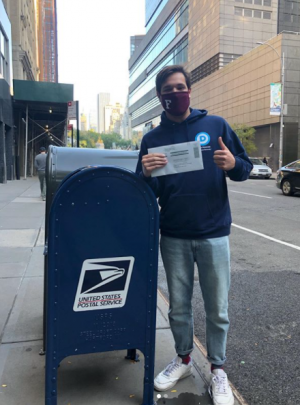The Image of the Politician, Adolescent or Otherwise
21 years since its release, Alexander Payne’s political satire ‘Election’ continues to question the morality of American politics
October 26, 2020
In the run up to the presidential election, every time a television is turned on, a politician is on screen expressing their contempt toward the opposing political party. Every time a debate is being aired, the two candidates are seen as either the lesser or greater of two evils. This is the (unfortunate) reality of living through an election season in the U.S.
But, that’s the nature of the politician, isn’t it? To put everything in front of them, and yet nothing in front of them. To preserve their appearance in such a way that makes their personal lives public while also concealing the so-called “real truth.”
In a continuous election with two candidates in the running for the presidency, both of whom are a source of contention, there arguably isn’t a more stressful time to be an American.
When the members of the two parties believe that their respective candidates can simply do no wrong, a central question arises: What do we really know about our candidates? More specifically, how far are they willing to go in order to remain as a voice of authority?
Everything we hear about these two candidates is often manipulated by the media, to the extent that factual information itself is practically nonexistent. We’re just going off of what we’ve been told, like the rest of the students at Carver High School.
In 1999, Alexander Payne and co-writer Jim Taylor answered that question with their adaptation of Tom Perrotta’s novel “Election.” Originally written and directed as a darkly comedic satire of American politics and the oh-so-coveted high school election, Payne’s film has garnered a larger following and greater acclaim.
Since its disappointing theatrical release, the film has gone on to receive a Criterion Collection re-release, a Best Adapted Screenplay nomination from the Academy of Motion Picture Arts and Sciences, and even holds the honor of being former President Barack Obama’s “favorite political movie.”
The film follows four different characters: Carver High School history teacher Jim McAllister (Matthew Broderick), the overachieving teacher’s pet Tracy Flick (Reese Witherspoon), the naive star quarterback Paul Metzler (Chris Klein) and his rebellious, closeted sister Tammy Metzler (Jessica Campbell).
On the surface, McAllister appears to be an ordinary teacher who genuinely cares about his students’ education. But much to his frustration, his life as a school teacher seems more gratifying than his life as a husband. Feeling distant from his own wife (both emotionally and sexually), McAllister finds himself attracted to Linda, the ex-wife of his friend and fellow high school teacher Dave Novotny (Mark Harelik).
Flick, considered by many to be the teenage Hillary Clinton, possesses a sense of tenacity that is more abrasive than it is endearing. She is shown setting up promotional stands in the school hallways, manufacturing her own campaign buttons and even resorting to tearing down Paul Metzler’s campaign posters after hours.
Much of Flick’s ambition can be attributed to her mother, who had always pushed her since she was a child. And it’s that kind of ambition that won’t let Flick lose sight of her dream to attend Georgetown University and eventually find success in the field of political science.
Not even a former teacher-student affair with Novotny is enough to destroy her dream, since most of the student body and faculty (except for McAllister) knows that it happened.
Paul Metzler, meanwhile, decides to run for the high school president position at the suggestion of McAllister. Because he was benched from the school’s football team as a result of a skiing accident, Paul Metzler finds a new purpose in his life by running for class president.
Paul Metzler’s commitment to the election isn’t even in the same stratosphere as Flick’s, as the only reason he has a chance at winning the election is because of his preestablished popularity. His image alone is enough to remind Flick of her distaste toward popular students, believing them to be beneath the success that awaits her.
Tammy Metzler doesn’t even pose a threat to Flick or Paul Metzler. She’s running for the position out of spite, since her girlfriend ended their relationship and subsequently became Paul’s girlfriend and his campaign manager. Out of her own disinterest with the election, Tammy Metzler purposefully claims that she was the one responsible for tearing down the posters, even though McAllister knows that Flick did it.
These four characters, particularly McAllister and Flick, attest to the importance of the politician’s image. McAllister’s morality isn’t always in the right place, but his intentions are well-meaning. Flick, however, values her own progress over everyone else’s, and is more than willing to step on anyone who attempts to obstruct her path.
In this sense, one could easily classify Republican presidential nominee Donald Trump as the “McAllister,” and Democratic presidential nominee Joe Biden as the “Flick” of this upcoming election, or vice-versa. But there is no “Paul Metzler.” There isn’t even a “Tammy Metzler.” There is only McAllister and Flick. And both nominees’ campaigns reflect that association, as they competitively manage their own images, always striving to appear in the best light.
After all, the preservation of the image comes first and foremost. For a candidate such as Trump, his activity on Twitter speaks for itself. For Flick, her image was always preserved. But nobody other than McAllister, would ever know the “real truth.” We already know the “real truth” of Payne’s film, but what we don’t know is the “real truth” of the upcoming election.
Everything we hear about these two candidates is often manipulated by the media, to the extent that factual information itself is practically nonexistent. We’re just going off of what we’ve been told, like the rest of the students at Carver High School.
So when you cast your ballots, remember to think about the image. Think about who you’re really voting for. In other words, think about “Election.”














